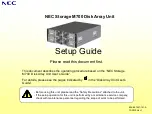
Chapter 4: Management with WebPAM PRO
117
The selected disk array disappears from the Disk Array List on the Information
tab.
Disk Array Information
The Disk Array–Information tab gives a description and reports the status of the
physical drives and logical drives that belong to this disk array. A disk array is a
collection of physical drives in a RAID. Logical drives are made from disk arrays.
To access a disk array:
1.
Click on the Subsystem
icon in Tree View.
2.
Click on the VTrak
icon.
3.
Click on the Disk Arrays icon.
4.
Click on the Disk Array
icon.
If you have used previous versions of WebPAM PRO, you may be unfamiliar with
the term "disk array". In earlier versions of WebPAM PRO, disk arrays ad logical
drives were created and managed as a single entity called “logical drive”.
In the latest version of WebPAM PRO, disk arrays and logical drives are created
separately. This change offers much greater flexibility in logical drive
management. As a result of the change, many of the features previously
associated with logical drives, such as RAID level, migration, synchronization
and rebuilding are now managed under disk arrays. They are the same functions
as before.
Enclosure Front View
The Enclosure Front View shows the enclosure location of the physical drives
that belong to this disk array.
Disk Array Information
•
Disk Array ID
– This is the ID number assigned by WebPAM PRO for this
disk array.
•
Alias
– A user-specified name for the disk array.
•
Operational Status
– Functional, Synchronizing, Rebuilding, Critical, or
Offline (see definitions below).
•
Configurable Capacity
– This is the data storage capacity available for new
and existing logical drives.
•
Free Capacity
– This is the data storage capacity available for new logical
drives.
•
Number of Physical Drives
– The number of physical drives that belong to
this disk array.
















































